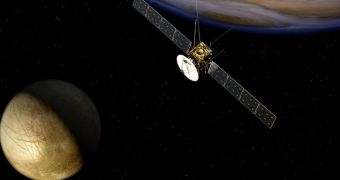Officials with the European Space Agency (ESA) announced yesterday, May 2, that the Jupiter Icy moons Explorer (JUICE) would be the organization's next large-scale science mission in the solar system.
As its name implies, the spacecraft will focus its attention on studying as many of Jupiter's icy moons as possible, in as much detail as possible. Objects in this class, which also exist in orbit around Saturn, are some of the most likely candidates for supporting basic lifeforms.
JUICE was not the only mission proposed to ESA. The agency favored it over two other proposals, one that called for the creation of a telescope dedicated to hunting for gravitational waves, the New Gravitational wave Observatory (NGO), and the Advanced Telescope for High-Energy Astrophysics.
According to representatives from the organization, this is the first Large-class (L-class) mission to be selected under the new ESA Cosmic Vision 2015-2025 program. The orbiter is currently scheduled for launch in 2022, from the agency's Kourou Spaceport, in French Guiana, South America.
This gives engineers, designers, mission planners and contractors a full decade to put the spacecraft together. ESA decided to go with the trusted Ariane 5 delivery system for this orbiter. The rocket is produced by French company Arianespace.
If the schedule put forth by the JUICE team is respected, the spacecraft should spend around 8 years en route to Jupiter, even though the gas giant lies beyond the orbit of Mars, which is around 8 months away. Arrival at destination is scheduled for 2030, and the mission will last for at least three years.
All Galilean moons are extremely interesting, scientists say. Io exhibits extreme volcanism (around 400 erupting volcanoes, the highest count of any body in the solar system), Europe is covered in ice, while Ganymede and Callisto have surfaces made up of rock-ice.
While analyzing the possibility of Europa, Ganymede and Callisto featuring oceans of liquid water at their cores, JUICE will also be investigating how the moons interact with Jupiter, as well as how the gas giant's atmosphere and magnetosphere work.
Ganymede is of special interest to ESA, since it represents the only moon in the solar system to generate its own magnetic field. Such a phenomenon could occur because it still has an active core. In any case, experts want to see how its magnetosphere interacts with that of Jupiter, through plasma.
“Jupiter is the archetype for the giant planets of the Solar System and for many giant planets being found around other stars. JUICE will give us better insight into how gas giants and their orbiting worlds form, and their potential for hosting life,” professor Alvaro Giménez Cañete explains.
He holds an appointment as the ESA Director of Science and Robotic Exploration. “JUICE is a necessary step for the future exploration of our outer Solar System,” he concludes. The next call for L-class missions will most likely occur next year.

 14 DAY TRIAL //
14 DAY TRIAL //